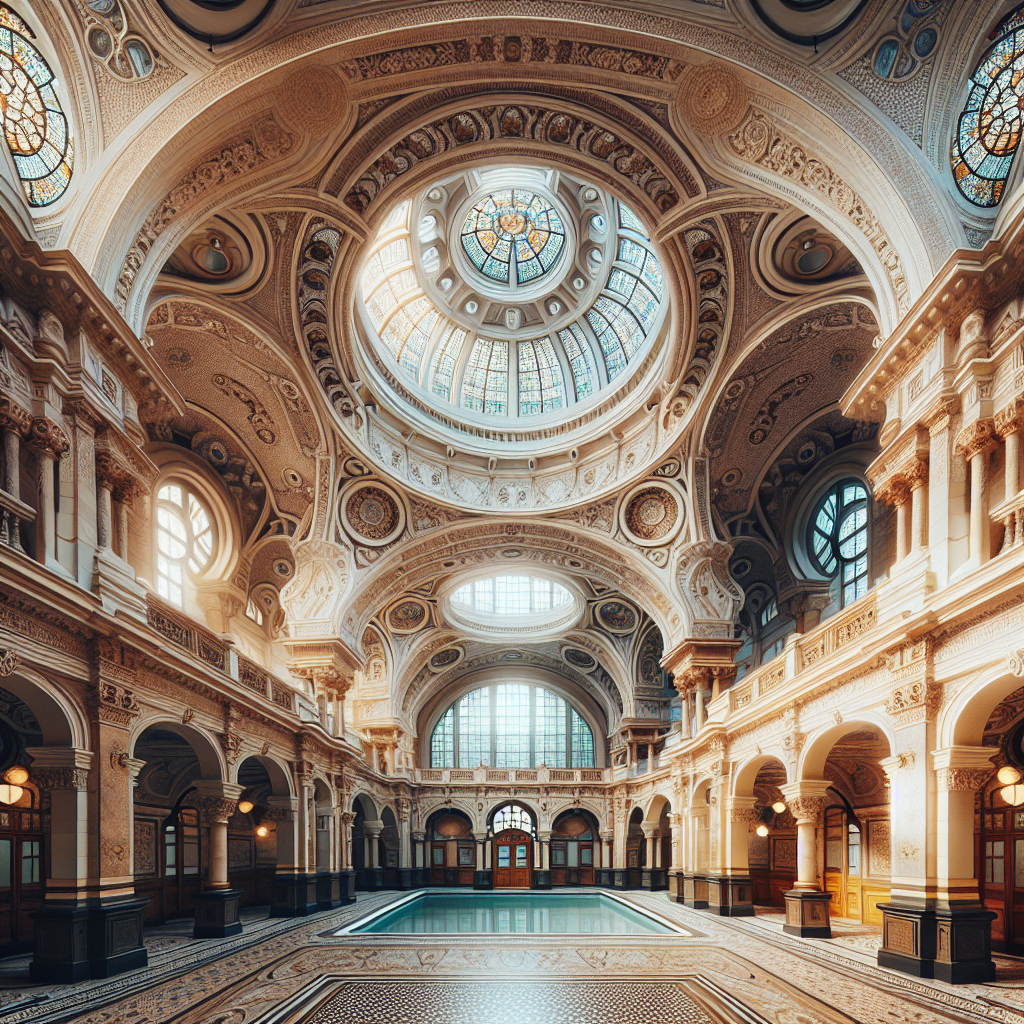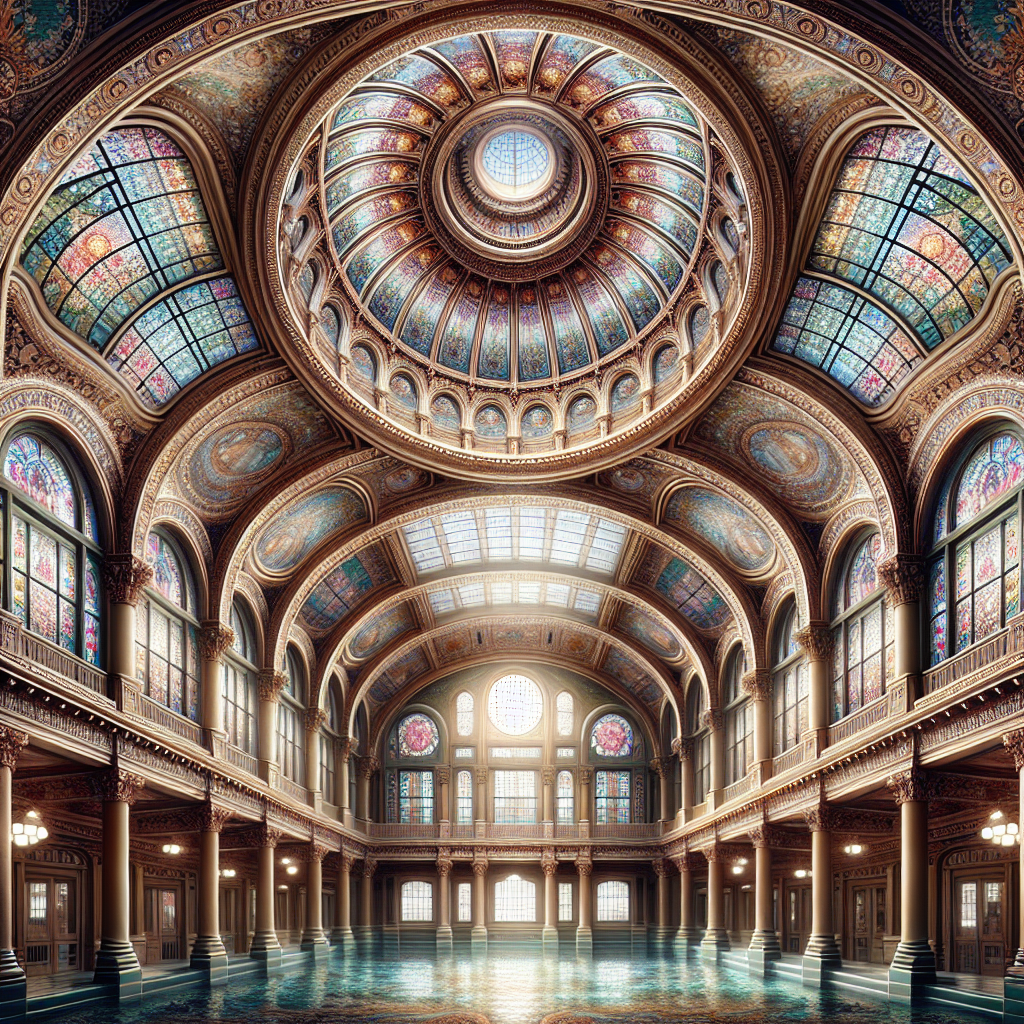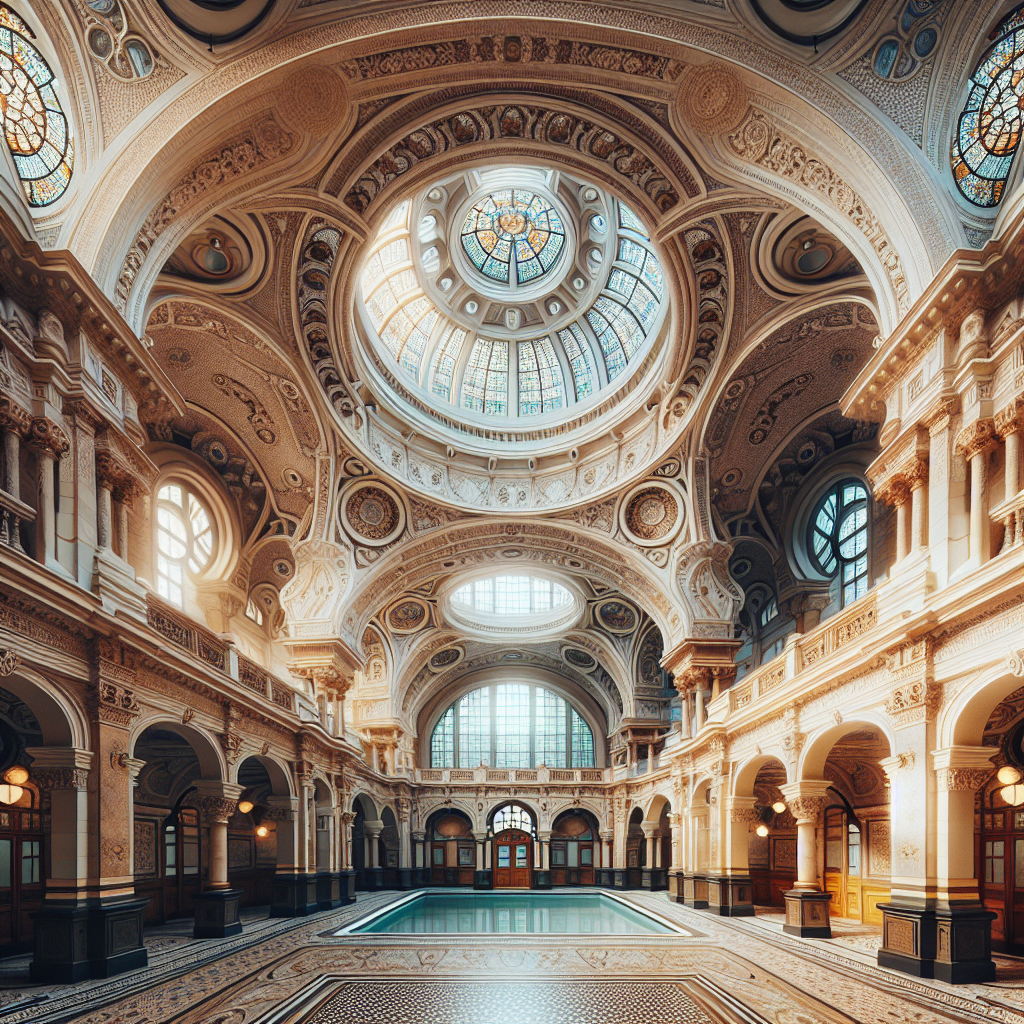Imagine stepping back in time and entering a world of grandeur and elegance. In the heart of Hot Springs, Arkansas, lies a collection of architectural marvels known as the historic bathhouses. These magnificent structures, adorned with intricate details and opulent designs, transport visitors to a bygone era where healing and relaxation were paramount. From the ornate stained glass windows to the mosaic-tiled floors, each bathhouse tells a tale of its own, showcasing the rich history and craftsmanship that went into creating these timeless treasures. Join us on a journey to explore the captivating beauty of the historic Hot Springs bathhouses and rediscover the artistry of the past.
1. The Origins of Hot Springs Bathhouses
Hot Springs bathhouses have a rich history that dates back to ancient times. Throughout various cultures and civilizations, the therapeutic benefits of hot springs were recognized and utilized for healing and relaxation.
1.1 Ancient Spa Culture
The concept of spa culture can be traced back to ancient civilizations such as the Egyptians, Greeks, and Romans. These cultures regarded hot springs as sacred sites and believed in their healing properties. The ancient Romans, in particular, played a significant role in shaping the foundations of bathhouse culture.
1.2 Roman Influence on Bathhouse Architecture
Roman bathhouses were not only functional but were also architectural wonders. They featured grand designs with intricate mosaics, marble columns, and sophisticated heating systems. The Roman bathhouses were not only places for bathing, but also served as social centers where people would gather, exercise, and engage in intellectual discussions.
1.3 Transformation of Bathhouses Over the Centuries
As civilizations advanced, so did the design and purpose of bathhouses. From simple structures in ancient times to elaborate and ornate buildings during the Renaissance, bathhouses continued to evolve. In later centuries, bathhouses became popular in European countries and eventually found their way to the United States with the arrival of European settlers.
2. Historical Significance of Hot Springs Bathhouses
Hot Springs bathhouses hold immense historical significance, particularly in the context of Native American culture and the development of early European settlements.
2.1 Role in Native American Culture
Long before the arrival of European settlers, Native American tribes regarded hot springs as sacred sites. They believed in the healing powers of the mineral-rich waters and used them for medicinal purposes. Native Americans practiced spiritual ceremonies and rituals near hot springs, viewing them as life-giving sources of rejuvenation.
2.2 Early European Settlements and Bathhouse Development
With the arrival of European settlers, the utilization of hot springs expanded. The first bathhouse in the United States was established in Hot Springs, Arkansas, in 1830. As more settlers discovered the benefits of hot springs, bathhouses were built to cater to the growing demand for therapeutics and social experiences.
2.3 Rise of Hot Springs as a Resort Destination
In the late 19th and early 20th centuries, hot springs gained popularity as resort destinations. People from all walks of life flocked to hot springs for relaxation, recreation, and healing. The establishment of railways and the rise of leisure travel played a significant role in the development of hot springs as sought-after tourist destinations.

3. Unique Architectural Styles of Hot Springs Bathhouses
Hot Springs bathhouses exhibit a variety of architectural styles, each reflecting the aesthetic preferences and prevailing design trends of its respective era.
3.1 Spanish Revival
One of the prominent architectural styles found in hot springs bathhouses is the Spanish Revival style. This style draws inspiration from Spanish colonial and Mission Revival architecture, featuring arched doorways, red tile roofs, and ornate decorative elements. The Spanish Revival style adds a touch of elegance and Mediterranean charm to the bathhouses.
3.2 Beaux-Arts Classicism
Bathhouses constructed in the Beaux-Arts style were influenced by the grandeur and opulence of European architecture during the late 19th and early 20th centuries. These bathhouses boast neoclassical features such as grand entrances, symmetrical facades, and elaborate ornamentation. Beaux-Arts bathhouses exude a sense of sophistication and refinement.
3.3 Art Deco
In the early 20th century, the Art Deco movement made its mark on bathhouse architecture. This style is characterized by geometric patterns, sleek lines, and bold, vibrant colors. Art Deco bathhouses display a sense of modernity and glamour, reflecting the spirit of the Roaring Twenties.
3.4 Victorian Influence
Victorian architecture also left its mark on hot springs bathhouses. Bathhouses constructed in the Victorian style feature intricate detailing, ornate moldings, and steep pitched roofs. These buildings evoke a sense of nostalgia and romanticism, transporting visitors back to the Victorian era.
3.5 Modernist Designs
Over time, bathhouse architecture embraced modernist design principles, characterized by simplicity, functionality, and the use of innovative materials. Modernist bathhouses focus on clean lines, open spaces, and a harmonious integration with the natural surroundings. These designs provide a contemporary twist to the traditional bathhouse experience.
4. The Grandeur of Bathhouse Row
Bathhouse Row in Hot Springs, Arkansas, stands as a testament to the architectural magnificence of historic hot springs bathhouses.
4.1 Magnificent Buildings Along Central Avenue
Bathhouse Row comprises a series of beautifully preserved bathhouses along Central Avenue. Each bathhouse exhibits unique architectural features, creating a captivating streetscape that reflects different eras of history and design.
4.2 Prominent Features of Bathhouse Row
The bathhouses along Bathhouse Row share some common features that contribute to their grandeur. Many of them have large, welcoming entrances adorned with decorative elements. Elaborate facades, elegant columns, and stunning detailing can be found throughout the row, showcasing the craftsmanship of the era.
4.3 Notable Bathhouses of Bathhouse Row
Among the notable bathhouses on Bathhouse Row are the Fordyce Bathhouse, the Buckstaff Bathhouse, and the Quapaw Bathhouse. The Fordyce Bathhouse, now transformed into a visitor center and museum, is a prime example of the opulent Beaux-Arts style. The Buckstaff Bathhouse, still in operation, showcases the Spanish Revival style. The Quapaw Bathhouse, renowned for its Native American-inspired design, provides a glimpse into the rich cultural heritage of Hot Springs.

5. Historic Preservation and Restoration Efforts
Preserving and restoring the architectural heritage of hot springs bathhouses is crucial to maintaining their cultural significance and providing a glimpse into the past.
5.1 Importance of Preserving Bathhouse Architecture
Preserving bathhouse architecture is essential as it allows future generations to appreciate the historical and cultural value of these structures. The preservation of bathhouses enables visitors to experience the magnificence of their design and understand the societal and technological advancements of the time.
5.2 Challenges in Restoring Historic Bathhouses
Restoring historic bathhouses comes with its own set of challenges. The preservation of original materials, the need for specialized craftsmanship, and adhering to strict preservation standards require extensive effort and resources. Funding these restoration projects can also present obstacles as it often involves public-private partnerships and community support.
5.3 Success Stories of Restoration Projects
Despite the challenges involved, several restoration projects have successfully breathed new life into historic bathhouses. The Fordyce Bathhouse, once on the verge of decay, has been meticulously restored to its former glory and now serves as a popular visitor center and museum. These success stories showcase the dedication and commitment of individuals and organizations in ensuring the preservation of bathhouse architecture.
6. Cultural and Recreational Activities in Bathhouses
Hot Springs bathhouses offer a wide range of cultural and recreational activities that enhance the overall experience for visitors.
6.1 Healing Properties of Hot Springs
The primary attraction of hot springs bathhouses lies in the healing properties of the mineral-rich waters. Visitors can immerse themselves in the therapeutic baths, believed to alleviate various ailments and promote overall well-being.
6.2 Spa Treatments and Therapies
In addition to the traditional hot springs baths, bathhouses provide a range of spa treatments and therapies. Visitors can indulge in massages, facials, and other wellness treatments, further enhancing the relaxation and rejuvenation experience.
6.3 Art and Cultural Exhibitions
Many bathhouses also serve as venues for art and cultural exhibitions. These exhibitions showcase local artists and provide a platform for the community to engage in artistic and cultural expressions.
6.4 Educational Programs and Workshops
Bathhouses often host educational programs and workshops that aim to educate visitors about the historical and cultural significance of hot springs, as well as the architectural heritage of bathhouses. Such programs provide an enriching experience and promote a deeper understanding of these unique structures.
6.5 Bathhouse Gardens and Outdoor Spaces
Bathhouses are often surrounded by beautifully landscaped gardens and outdoor spaces. These areas provide visitors with a tranquil environment to relax and enjoy the natural surroundings, further enhancing the overall experience of visiting hot springs bathhouses.
7. Hot Springs Bathhouses as National Historic Landmarks
Hot Springs bathhouses, particularly those on Bathhouse Row, have been recognized as national historic landmarks for their architectural significance.
7.1 Bathhouse Row’s Designation as a National Historic Landmark
In 1987, Bathhouse Row, along with the surrounding Hot Springs National Park, was designated as a National Historic Landmark. This designation acknowledges the historical, architectural, and cultural significance of the bathhouses and ensures their long-term preservation and protection.
7.2 Criteria for Recognizing Bathhouses as Landmarks
To be recognized as a national historic landmark, bathhouses must meet specific criteria established by the U.S. National Park Service. These criteria include exceptional importance to the nation’s history, association with significant events or individuals, and possessing distinctive architectural characteristics.
7.3 Preservation Benefits and Responsibilities
Being designated as national historic landmarks opens up opportunities for funding and grants dedicated to the preservation and restoration of these bathhouses. It also heightens public awareness and appreciation of their historical and cultural value. The responsibility of preserving and maintaining these landmarks falls on the shoulders of both the government and the community.
8. Hot Springs Bathhouses in Popular Culture
Hot Springs bathhouses have left a significant imprint on popular culture, with references and inspirations found in various forms of media.
8.1 Hot Springs Bathhouses in Movies and TV Shows
Hot Springs bathhouses have served as iconic backdrops in numerous movies and TV shows. Their stunning architecture and historical significance often provide a unique setting for storytelling. From period dramas to comedies, bathhouses have become synonymous with the allure and charm of Hot Springs.
8.2 Literary Inspirations from Hot Springs Bathhouses
Many writers have drawn inspiration from the captivating atmosphere of hot springs bathhouses. Books and novels set in and around these sites have showcased the beauty of the architecture and transported readers into the fascinating world of bathhouse culture.
8.3 Popularity of Bathhouses in Travel and Leisure Publications
Hot Springs bathhouses have captured the attention of travel and leisure publications, which highlight their historical significance and unique offerings. These publications often feature bathhouses as must-visit destinations for both history enthusiasts and those seeking relaxation and wellness experiences.
9. International Influence on Hot Springs Bathhouse Architecture
The architectural styles of hot springs bathhouses have been influenced by various cultures and traditions from around the world.
9.1 Influence of European Spa Towns
Bathhouse architecture in hot springs owes much to the influence of European spa towns. The designs of bathhouses in European countries such as Germany, Austria, and France have inspired the development of hot springs bathhouses in the United States. Elements of Roman, Greek, and Victorian architecture can be seen in these structures, reflecting the European influence.
9.2 Asian Bathhouse Traditions
Asian bathhouse traditions, particularly in countries like Japan and Korea, have also had an impact on hot springs bathhouse architecture. The tranquility and simplicity of Asian design philosophies can be seen in the overall aesthetic and layout of some bathhouses, creating serene and peaceful environments for visitors.
9.3 Fusion of Cultural Designs in Modern Bathhouses
Contemporary bathhouses often blend various cultural designs to create unique and innovative architectural styles. The fusion of different influences allows for the creation of bathhouses that cater to the diverse tastes of visitors while still paying homage to their historical roots.
10. Future of Hot Springs Bathhouse Architecture
The future of hot springs bathhouse architecture lies in contemporary innovations, sustainable practices, and the continued preservation and adaptation of these historic structures.
10.1 Contemporary Innovations in Bathhouse Design
Contemporary bathhouse design incorporates innovative technologies and architectural concepts. The integration of modern amenities, such as advanced water filtration systems and energy-efficient heating, ensures a more sustainable and enjoyable experience for visitors.
10.2 Sustainable Practices in Bathhouse Construction
In an era where sustainability is paramount, bathhouse construction is increasingly focusing on environmentally friendly practices. Solar panels, rainwater harvesting systems, and eco-friendly building materials are becoming integral components of bathhouse design, minimizing the environmental impact while preserving the historical integrity of these structures.
10.3 Preservation and Adaptation for Future Generations
Preservation and adaptation are key for the future of hot springs bathhouses. By preserving the historical architecture and cultural significance, future generations can continue to appreciate the rich heritage of these structures. At the same time, adapting bathhouses to meet the evolving needs of visitors ensures their continued relevance and sustains the economic and cultural benefits they bring to their surrounding communities.
In conclusion, hot springs bathhouses have a fascinating history, spanning various cultures and architectural styles. They hold immense historic and cultural significance, and their architectural marvels continue to awe visitors from around the world. As these structures are transformed into cultural hubs and destinations, their preservation, restoration, and adaptation for future generations are vital to ensure their enduring legacy and continued enjoyment.
